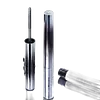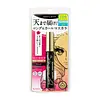Judydoll 3D Curling Eyelash Iron Mascara Versus ISEHAN Heroine Make Long Up Mascara Super Waterproof
What's inside
What's inside
 Key Ingredients
Key Ingredients

 Benefits
Benefits

 Concerns
Concerns

 Ingredients Side-by-side
Ingredients Side-by-side

Isododecane
EmollientTrimethylsiloxysilicate
EmollientDextrin Palmitate
EmulsifyingMicrocrystalline Wax
Emulsion StabilisingCeresin
Emulsion StabilisingPolypropylsilsesquioxane
Paraffin
PerfumingBenzalkonium Montmorillonite
EmulsifyingHydrogenated Polyisobutene
EmollientSynthetic Wax
AbrasiveRayon
CI 77491
Cosmetic ColorantCI 77499
Cosmetic ColorantCI 77007
Cosmetic ColorantPropylene Carbonate
SolventSilica
AbrasivePolymethylsilsesquioxane
Phenethyl Alcohol
MaskingCaprylic/Capric Glycerides Polyglyceryl-10 Esters
EmollientCI 77492
Cosmetic ColorantMica
Cosmetic ColorantCI 75470
Cosmetic ColorantTriethoxycaprylylsilane
CI 77266
Cosmetic ColorantPanthenol
Skin ConditioningBHT
AntioxidantIsododecane, Trimethylsiloxysilicate, Dextrin Palmitate, Microcrystalline Wax, Ceresin, Polypropylsilsesquioxane, Paraffin, Benzalkonium Montmorillonite, Hydrogenated Polyisobutene, Synthetic Wax, Rayon, CI 77491, CI 77499, CI 77007, Propylene Carbonate, Silica, Polymethylsilsesquioxane, Phenethyl Alcohol, Caprylic/Capric Glycerides Polyglyceryl-10 Esters, CI 77492, Mica, CI 75470, Triethoxycaprylylsilane, CI 77266, Panthenol, BHT
Isododecane
EmollientTrimethylsiloxysilicate
EmollientTalc
AbrasiveMicrocrystalline Wax
Emulsion StabilisingCeresin
Emulsion StabilisingDisteardimonium Hectorite
StabilisingDextrin
AbsorbentHydrogenated Polyisobutene
EmollientPropylene Carbonate
SolventPrunus Amygdalus Dulcis Oil
Skin ConditioningCamellia Seed Oil
Argania Spinosa Kernel Oil
EmollientRosa Canina Fruit Oil
EmollientDaucus Carota Sativa Root Extract
Skin ConditioningRoyal Jelly Extract
Skin ConditioningNylon-66
Sucrose Tristearate
EmollientAluminum Distearate
Emulsion StabilisingGlyceryl Isostearate
EmollientTrimethylsiloxysilylcarbamoyl Pullulan
Polymethylsilsesquioxane
Lauric Acid
CleansingZinc
AntioxidantSilica
AbrasiveSqualane
EmollientAcrylates/Ethylhexyl Acrylate Copolymer
Hydroxyethyl Acrylate/Methoxyethyl Acrylate Copolymer
Dimethicone
EmollientAmmonium Acrylates Copolymer
Sodium Dehydroacetate
PreservativeTocopherol
AntioxidantDiethyl Ascorbic Acid
Skin ConditioningCI 77492
Cosmetic ColorantTitanium Dioxide
Cosmetic ColorantIsododecane, Trimethylsiloxysilicate, Talc, Microcrystalline Wax, Ceresin, Disteardimonium Hectorite, Dextrin, Hydrogenated Polyisobutene, Propylene Carbonate, Prunus Amygdalus Dulcis Oil, Camellia Seed Oil, Argania Spinosa Kernel Oil, Rosa Canina Fruit Oil, Daucus Carota Sativa Root Extract, Royal Jelly Extract, Nylon-66, Sucrose Tristearate, Aluminum Distearate, Glyceryl Isostearate, Trimethylsiloxysilylcarbamoyl Pullulan, Polymethylsilsesquioxane, Lauric Acid, Zinc, Silica, Squalane, Acrylates/Ethylhexyl Acrylate Copolymer, Hydroxyethyl Acrylate/Methoxyethyl Acrylate Copolymer, Dimethicone, Ammonium Acrylates Copolymer, Sodium Dehydroacetate, Tocopherol, Diethyl Ascorbic Acid, CI 77492, Titanium Dioxide
 Reviews
Reviews

Ingredients Explained
These ingredients are found in both products.
Ingredients higher up in an ingredient list are typically present in a larger amount.
Ceresin is a wax derived from ozokerite. It is an alternative to beeswax.
The most common process of creating ceresin is by using heat and sulfuric acid.
Ci 77492 is also hydrated iron III oxide. It's sole purpose is to give a yellow hue to products.
Iron III oxides are classified as inorganic chemicals for coloring.
Synthetically created Ci 77492 is considered safer than those naturally found. This is because the synthetically created version may contain less impurities. Iron oxides are generally non-toxic and non-allergenic.
Learn more about CI 77492Hydrogenated Polyisobutene is a synthetic polymer. Polymers are compounds with high molecular weight. Hydrogenated Polyisobutene is an emollient and texture enhancer.
In one study, Hydrogenated Polyisobutene showed better skin hydration levels than Caprylic/Capric Triglyceride. As an emollient, it helps keep your skin soft and hydrated by trapping moisture in.
Hydrogenated Polyisobutene is often used as a mineral oil replacement.
Learn more about Hydrogenated PolyisobuteneIsododecane is a fragrance, emollient, and solvent.
As an emollient, it helps your skin stay soft and hydrated. Emollients help trap moisture into your skin.
Isododecane's role as a solvent makes it a great texture enhancer. It spreads smoothly on skin and does not leave a sticky feeling behind. Isododecane also helps prevent color transfer in makeup products.
Isododecane is not absorbed into skin.
Learn more about IsododecaneMicrocrystalline Wax is created by de-oiling petroleum. It is highly refined and purified before being added to cosmetics.
Microcrystalline Wax is used to enhance the texture and create even consistency. It helps stabilize a product by preventing ingredients from separating.
Polymethylsilsesquioxane is a silicone used as a film forming agent.
When applied to the skin, this ingredient creates an invisible film on the surface. This film still allows oxygen to pass through, but prevents moisture from escaping. This can help condition and hydrate the skin. It also leaves a silky feel when applied.
Polymethylsilsesquioxane has not been shown to clog pores. It has been deemed safe to use up to 55%, but most cosmetics use much less.
If you have concerns about using this ingredient, we recommend speaking with a professional.
Learn more about PolymethylsilsesquioxaneThis ingredient is a solvent. It helps dissolve active ingredients and alter the texture of products.
Propylene Carbonate is commonly used in makeup and with clay, such as montmorillonite or bentonite.
Studies show this ingredient to be safe for cosmetics. When it is undiluted, it can cause skin irritation. (It is always diluted in skincare and makeup). This ingredient is water-soluble.
Propylene Carbonate is created from propylene glycol and carbonic acid.
Learn more about Propylene CarbonateSilica, also known as silicon dioxide, is a naturally occurring mineral. It is used as a fine, spherical, and porous powder in cosmetics.
Though it has exfoliant properties, the function of silica varies depending on the product.
The unique structure of silica enhances the spreadability and adds smoothness, making it a great texture enhancer.
It is also used as an active carrier, emulsifier, and mattifier due to its ability to absorb excess oil.
In some products, tiny microneedles called spicules are made from silica or hydrolyzed sponge. When you rub them in, they lightly polish away dead skin layers and enhance the penetration of active ingredients.
Learn more about SilicaThis silicone is an emollient. Emollients create a thin film on the skin to prevent moisture from escaping.
It is not soluble in water and helps increase water-resistance in products.
According to a manufacturer, it can blend seamlessly with silicone oils, such as Cyclopentasiloxane.
Learn more about Trimethylsiloxysilicate